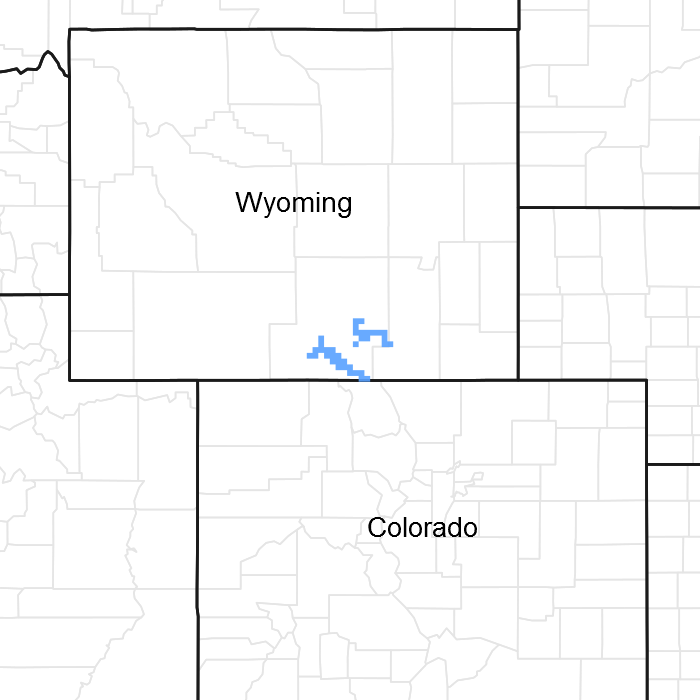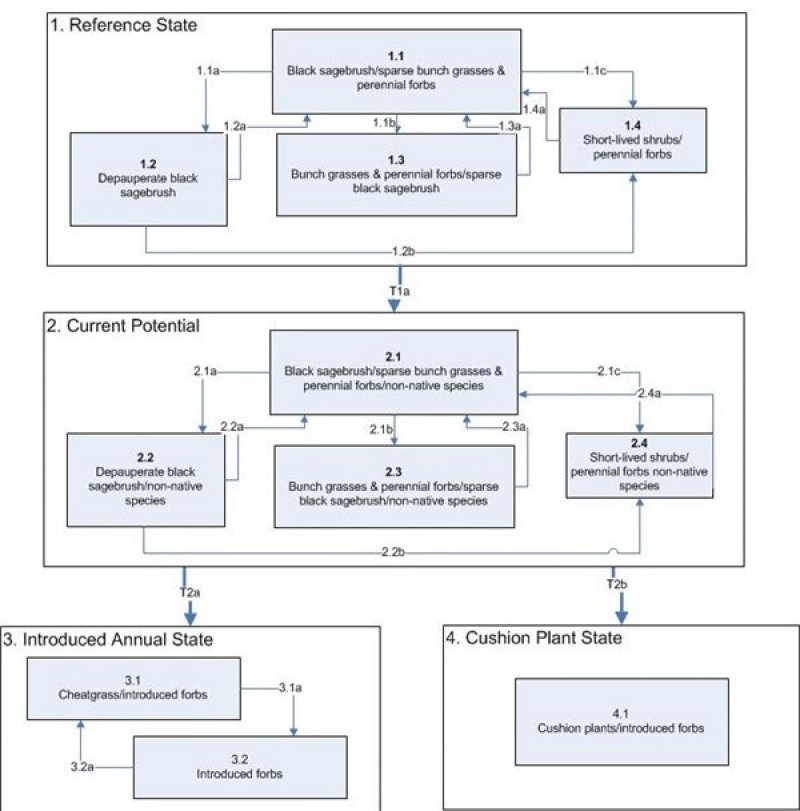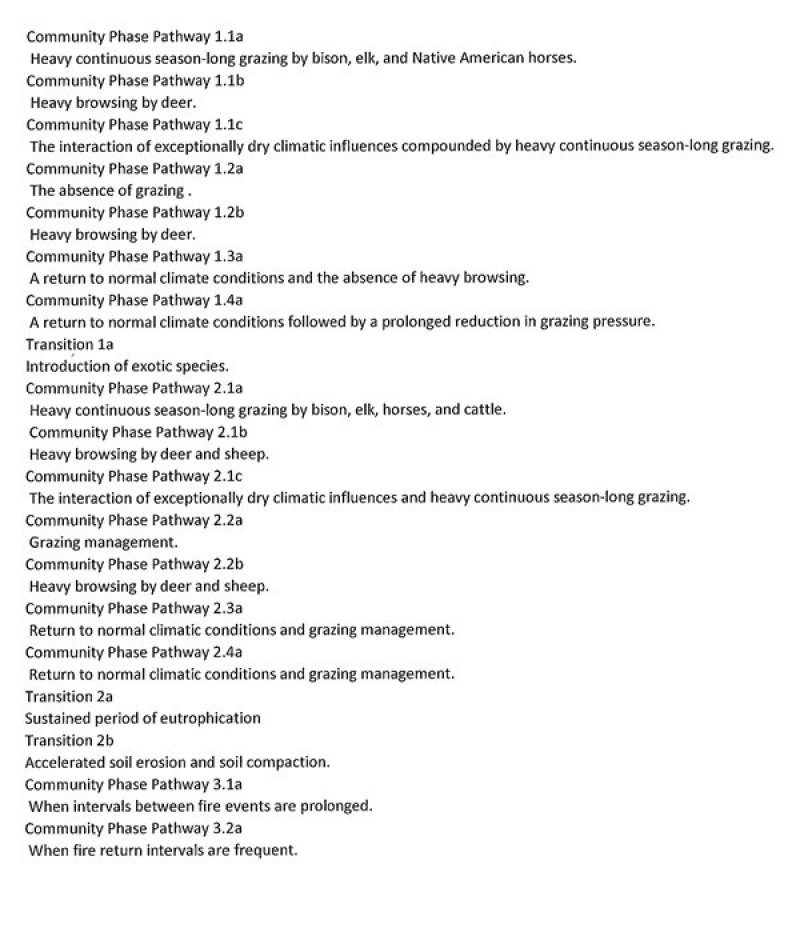Ecological dynamics
It is impossible to determine in any quantitative detail the historic climax plant community (HCPC) for this ecological site because of the lack of direct historical documentation preceding all human influence. In some areas, the earliest reports of dominant plants include the cadastral survey conducted by the General Land Office, which began in the late 19th century for this area (Galatowitsch 1990). However, up to the 1870s the Shoshone Indians, prevalent in northern Utah and neighboring states, grazed horses and set fires to alter the vegetation for their needs (Parson 1996). In the 1860s, Europeans brought cattle and horses to the area grazing large numbers of them on unfenced parcels year-long (Parson 1996). Itinerant and local sheep flocks followed as the proportion of browse increased.
Below is a State and Transition Model diagram to illustrate the “phases” (common plant communities), and “states” (aggregations of those plant communities) that can occur on the site. Differences between phases and states depend primarily upon observations of a range of disturbance histories in areas where this ESD is represented. These situations include grazing gradients to water sources, fence-line contrasts, patches with differing dates of fire, herbicide treatment, tillage, etc. Reference State 1 illustrates the common plant communities that probably existed just prior to European settlement.
The major successional pathways within states, (“community pathways”) are indicated by arrows between phases. “Transitions” are indicated by arrows between states. The drivers of these changes are indicated in codes decipherable by referring to the legend at the bottom of the page and by reading the detailed narratives that follow the diagram. The transition between Reference State 1 and State 2 is considered irreversible because of the naturalization of exotic species of both flora and fauna, possible extinction of native species, and climate change. There may have also been accelerated soil erosion.
When available, monitoring data (of various types) were employed to validate more subjective inferences made in this diagram. See the complete files in the office of the State Range Conservationist for more details.
The plant communities shown in this State and Transition Model may not represent every possibility, but are probably the most prevalent and recurring plant communities. As more monitoring data are collected, some phases or states may be revised, removed, and/or new ones may be added. None of these plant communities should necessarily be thought of as “Desired Plant Communities.” According to the USDA NRCS National Range & Pasture Handbook (USDA-NRCS 2003), Desired Plant Communities (DPC’s) will be determined by the decision-makers and will meet minimum quality criteria established by the NRCS. The main purpose for including descriptions of a plant community is to capture the current knowledge at the time of this revision.
State 1: Reference State
The Reference State is a description of this ecological site just prior to Euro-American settlement but long after the arrival of Native Americans. The description of the Reference State was determined by NRCS Soil Survey Type Site Location information, and familiarity with rangeland relict areas where they exist. The least modified plant community (1.1) within the Reference State would have been a black sagebrush-dominated (Artemisia nova) stand and associated bunch grasses as well as common forb species. The generally shallow and stony soils would have accentuated the effects of drought and reduced the chances of fire altering this state. The reference plant community (1.1) would have been relatively stable with occasional use by wildlife. However, heavy utilization by bison, elk, and Native American horses on these sites (1.1a) would have depleted the grasses creating a near monoculture of black sagebrush (1.2). Heavy browsing by deer during the dormant season of black sagebrush (1.1b) would have created an herbaceous variant (1.3). Occasional very wet years during El Nino-Southern Oscillation periods could have caused temporary soil anoxia (West 2000) (1.1c) killing the sagebrush and allowing the forbs and grasses to dominate for a short time (1.3). Infestation of some insects and pathogens on sagebrush (1.1c) could have led to a similar result where the herbaceous species become temporarily dominant (1.3). The interaction of an unusually dry period and heavy utilization by all grazers (e.g. deer, bison, elk, and horses used by native American) (1.1d) would have removed the palatable species from the plant community while allowing unpalatable, shorter-lived species such as yellow rabbitbrush (Chrysothamnus viscidiflorus ssp. viscidiflorus), , and phlox to predominate (1.4). The depauperate black sagebrush (Artemisia nova) community (1.2) could have also shifted to the unpalatable short-lived shrub community phase (1.4) in areas that have sustained heavy browsing by deer (1.2b). Relatively rocky sites such as these typically would not have declined in overall cover or productivity. However, the portion that is palatable may have changed appreciably. Similarly, these soils would have been more resistant to erosion than other stone-free soils. Each of the phases within State 1 could have returned to Community Phase 1.1 if climate conditions were within the normal range of variability and there was a release from heavy grazing and/or browsing pressure (1.2a, 1.3a, 1.4a).
The least modified plant community within the Reference State would have been a black sagebrush-dominated stand and associated bunch grasses and commonly associated forbs.
Community Phase Pathway 1.1a
Heavy continuous season-long grazing by bison, elk, and Native American horses would have converted the Reference State to a depauperate black sagebrush community.
Community Phase Pathway 1.1b
Heavy browsing by deer would have converted the Reference State to a plant community dominated by bunchgrasses and perennial forbs. An extremely wet period such as an El Nino-Southern Oscillation event and subsequent anoxious soil conditions would have converted the Reference State to a plant community dominated by bunchgrasses and perennial forbs. The same result would occur following a sudden insect (or other pathogen) outbreak on sagebrush.
Community Phase Pathway 1.1c
The interaction of exceptionally dry climatic influences compounded by heavy continuous season-long grazing by all grazers including deer, bison, elk, and Native American horses, would have converted the Reference State to an unpalatable short-lived shrub & perennial forb plant community.
Community Phase 1.2: Depauperate black sagebrush
This plant community would have developed under heavy continuous season-long grazing by bison, elk, and Native American horses. Heavy utilization of grasses would have created a near monoculture of black sagebrush.
Community Phase Pathway 1.2a
The absence of grazing would have allowed the native bunchgrasses and perennial forbs to return to the system converting it back to the Community Phase 1.1.
Community Phase Pathway 1.2b
Heavy browsing by deer would have converted the depauperate black sagebrush community to an unpalatable short-lived shrub community phase.
Community Phase 1.3: Bunch grasses & Perennial Forbs/Sparse black sagebrush
There are several environmental conditions that would have produced this plant community. Heavy browsing by deer would have resulted in an herbaceous-dominated variant because of the utilization of black sagebrush during the dormant season. Under the occasional very wet period associated with an El Nino-Southern Oscillation event, temporary soil anoxia could have developed (West 2000), killing the sagebrush and allowing the forbs and grasses to dominate for a short time. A similar plant community would have also developed following an outbreak of insects and pathogens where sagebrush was the dominant host.
Community Phase Pathway 1.3a
A return to normal climate conditions and the absence of heavy browsing would have allowed black sagebrush to re-establish and convert back to the Community Phase 1.1.
Community Phase 1.4: Short-lived Shrubs/Perennial Forbs
This plant community would have developed under the combined effect of unusual drought conditions and heavy grazing by all grazers including deer, bison, elk, and Native American horses. Focused utilization would have reduced the palatable species while allowing the noxious, unpalatable, and shorter-lived species such as yellow rabbitbrush, and phlox to predominate.
Community Phase Pathway 1.4a
A return to normal climate conditions followed by a prolonged reduction in grazing pressure would have allowed black sagebrush and native bunchgrasses to re-establish returning to the reference plant community (1.1).
Transition 1a
The simultaneous introduction of exotic species, both plants and animals, and possible extinctions of native flora and fauna, along with climate change, will cause State 1 to transition to State 2. A return pathway back to State 1 would be impracticable because of these issues.
State 2: Black Sagebrush/ Introduced Non-natives State
State 2 is identical to State 1 in form and function, with the exception of the presence of non-native plants and animals, possible extinctions of native species, and a different climate. State 2 is a description of the ecological site shortly following Euro-American settlement, which can be regarded as the current potential. The least modified plant community (2.1) within State 2 is a black sagebrush-dominated stand and associated bunch grasses such as bluebunch wheatgrass, muttongrass, and Salina Wildrye and Columbia needlegrass. Forbs such as Phlox, stonecrop and rock goldenrod are common. The generally shallow and stony soils accentuate the effect of drought and reduce the chances of fires altering this state. This plant community is relatively stable under mixed use by wildlife and livestock. However, heavy utilization by bison, elk, horses, and domestic cattle on these sites during the growing season (2.1a) would deplete the grasses creating a near monoculture of black sagebrush (2.2). Heavy browsing by deer and sheep (2.1b) would create an herbaceous variant (2.3) because of year-round utilization of black sagebrush. Occasionally very wet years during El Nino-Southern Oscillation periods can cause temporary soil anoxia (West 2000) (2.1c) killing the sagebrush and allowing the forbs and grasses to dominate for a short time (2.3). Some insects and pathogens on sagebrush (2.1c) can lead to a similar result where the herbaceous species become temporarily dominant (2.3). The interaction of an unusually dry period and heavy utilization of grasses by bison, elk, horses, and domestic cattle (2.1d) would remove the palatable species from the plant community while allowing unpalatable, shorter-lived species such as yellow rabbitbrush, and phlox to predominate. Species composition does not change, jus their abundance (2.4). The depauperate black sagebrush community (2.2) may also shift to the unpalatable short-lived shrub community phase (2.4) with heavy utilization of browse by deer and sheep (2.2b). Relatively rocky sites such as these typically do not decline in overall cover or productivity, however, the portion that is palatable may change appreciably. Similarly, these soils are more resistant to erosion than associated stone-free soils. Each of the phases within State 2 can return to Community Phase 2.1 when climate conditions are within the normal range of variability and grazing pressure is moderated (2.2a, 2.3a, 2.4a).
Community Phase 2.1: Black sagebrush/Sparse bunchgrasses & Perennial forbs
The least modified plant community within the Black Sagebrush/ Introduced Non-natives State is a black sagebrush-dominated stand and associated bunch grasses such as bluebunch wheatgrass, muttongrass, and Salina Wildrye and Columbia needlegrass. Phlox, stonecrop and rock goldenrod are commonly associated forbs.
Community Phase Pathway 2.1a
Heavy continuous season-long grazing by bison, elk, horses, and cattle would convert the Black sagebrush/ Sparse bunchgrasses & Perennial forbs phase to a depauperate black sagebrush community.
Community Phase Pathway 2.1b
Heavy browsing by deer and sheep would convert the Black sagebrush/ Sparse bunchgrasses & Perennial forbs phase to a plant community dominated by bunchgrasses and perennial forbs. An extremely wet period such as an El Nino-Southern Oscillation event and subsequent anoxious soil conditions would convert the Black sagebrush/ Sparse bunchgrasses & Perennial forbs phase to a plant community dominated by bunchgrasses and perennial forbs. The same result would be seen following a sudden insect (or other pathogen) outbreak on sagebrush.
Community Phase Pathway 2.1c
The interaction of exceptionally dry climatic influences and heavy continuous season-long grazing by all grazers would convert the Black sagebrush/ Sparse bunchgrasses & Perennial forbs phase to an unpalatable short-lived shrub and perennial forb plant community.
Community Phase 2.2: Depauperate Black sagebrush
This plant community is developed under heavy continuous season-long grazing by bison, elk, cattle, and horses. Heavy utilization of grasses creates a near monoculture of black sagebrush.
Community Phase Pathway 2.2a
This plant community can move back towards the Black sagebrush/ Sparse bunchgrasses & Perennial forbs phase when grazing management, particularly of sheep, and use by deer, take place only during the non-growing season of the herbaceous component, along with broadcast re-seeding with native perennial forbs and grasses.
Community Phase Pathway 2.2b
Heavy browsing by deer and sheep would convert the depauperate black sagebrush phase to the unpalatable short-lived shrub and perennial forb community
Community Phase 2.3: Bunch grasses & perennial forbs/ Sparse black sagebrush
There are several environmental conditions that would produce this plant community. Heavy year-round browsing by deer and sheep would result in an herbaceous-dominated variant because of the utilization of black sagebrush. Following the occasional very wet period associated with an El Nino-Southern Oscillation event, temporary soil anoxia could develop, (West 2000) killing the sagebrush and allowing the forbs and grasses to dominate for a short time. A similar plant community would also develop following an outbreak of insects and pathogens where sagebrush is the dominant host.
Community Phase Pathway 2.3a
This plant community can move back to the Black sagebrush/ Sparse bunchgrasses & Perennial forbs phase with a return to normal climate conditions and when grazing by both livestock and wildlife is concentrated during the spring to put pressure on the herbaceous component, allowing the native woody component to re-establish.
Community Phase 2.4: Short-lived shrubs/perennial forbs
This plant community is developed under extreme drought conditions combined with heavy continuous season-long grazing. Such disturbances will reduce the palatable species and allow the unpalatable, shorter-lived species such as yellow rabbitbrush, and phlox to predominate. Because of the prevalence of historic unrestricted ungulate grazing, this is the most likely of the phases within State 2 to transition to States 3 or 4.
Community Phase Pathway 2.4a
A return to the Black sagebrush/ Sparse bunchgrasses & Perennial forbs phase is possible with a return to normal (or wetter) climate conditions and high intensity short duration grazing management to allow the native woody component to re-establish and decrease the competition by herbaceous species.
Transition 2a
The Black Sagebrush/ Introduced Non-natives State will transition to the Introduced Annuals/Biennials State following a sustained period of eutrophication caused by excessive year-long livestock grazing, trampling and bedding, especially by large flocks of domestic sheep. Sheep bedding, salting, watering, and handling locations involve intensive trampling, urination, defecation, and consequent eutrophication, which can be influential in this type of transition. It is also common to see accelerated soil erosion in such locations.
Transition 2b
The Black Sagebrush/ Introduced Non-natives State will transition to the Cushion Plant State under conditions marked by accelerated soil erosion and soil compaction caused by mechanical damage from trail and road development, excessive trail/foot traffic, and/or jeep/ATV impacts resulting in permanent reduction of plant cover.
State 3: Introduced Annuals/Biennials State
Invasive annuals and biennial forbs such as cheatgrass (Bromus tectorum), Russian thistle (Salsola tragus), knapweeds (Centaurea spp.), and horehound (Marrubium vulgare) are favored by an increase in nutrient build-up in old, eutrophicated sheep bedgrounds. Where fire return intervals are frequent (3.2a) annuals such as cheatgrass and Russian thistle will predominate (3.1). Longer intervals between fire events (3.1a) will result in a plant community dominated by biennial forbs (3.2). The soil profiles of the plant communities within this state are mainly intact.
Although there have been previous attempts to apply tillage and chemicals to improve the composition and productivity in areas where the ESD has developed into this state (see files in the State Range Conservationist Office for details), the biological responses may be too low to justify the economic investment. Therefore, currently available rangeland manipulations are not recommended.
Community Phase 3.1: Annual grass/annual forb
This plant community will develop where fire return intervals are frequent and annual species such as cheatgrass and Russian thistle predominate.
Community Phase Pathway 3.1a
When intervals between fire events are prolonged, biennial forbs will dominate the plant community.
Community Phase 3.2: Annual forb/beinnal forb
This plant community will develop when intervals between fires are longer, allowing biennial species such as knapweeds, tumblemustard (Sisymbrium altissimum), and Dyer’s woad (Isatis tinctoria) to become established.
Community Phase Pathway 3.2a
When fire return intervals are frequent, annual forbs and grasses will dominate the plant community.
State 4: Cushion Plant State
Curlycup gumweed (Grindelia squarrosa) and other cushion plants such as spiny phlox (Phlox hoodii), pricklyphlox (Leptodactylon spp.), etc. are found on highly eroded sites, where accelerated soil erosion and soil compaction caused by mechanical damage has removed the fine soil particles and compacted the soils leaving a rocky self-armored surface (4.1).
As with State 3, although there have been previous attempts to apply tillage and chemicals to improve the composition and productivity in areas where the ESD has developed into this state (see files in the State Range Conservationist Office for details), the biological responses may be too low to justify the economic investment. Therefore, currently available rangeland manipulations are not recommended.
Community Phase 4.1: Cushion Plant/annual forb
his plant community will develop following prolonged mechanical damage caused by trail and road development, excessive trail/foot traffic, and/or jeep/ATV impacts resulting in permanent reduction of plant cover. The only plants remaining are those tolerant of drought, infertile soil, and mechanical disturbances.
Community 1.1
Reference Plant Community
The general view of this site is black sagebrush and grass. The composition by air-dry weight is approximately 40 percent perennial grasses, 10 percent forbs, and 50 percent shrubs.
Table 5. Annual production by plant type
| Plant type |
Low
(lb/acre) |
Representative value
(lb/acre) |
High
(lb/acre) |
| Shrub/Vine |
225 |
350 |
475 |
| Grass/Grasslike |
180 |
280 |
380 |
| Forb |
45 |
70 |
95 |
| Total |
450 |
700 |
950 |
Table 6. Ground cover
| Tree foliar cover |
0%
|
| Shrub/vine/liana foliar cover |
34-36%
|
| Grass/grasslike foliar cover |
24-26%
|
| Forb foliar cover |
4-6%
|
| Non-vascular plants |
0%
|
| Biological crusts |
0%
|
| Litter |
0%
|
| Surface fragments >0.25" and <=3" |
0%
|
| Surface fragments >3" |
0%
|
| Bedrock |
0%
|
| Water |
0%
|
| Bare ground |
0%
|
Table 7. Canopy structure (% cover)
| Height Above Ground (ft) |
Tree |
Shrub/Vine |
Grass/
Grasslike |
Forb |
| <0.5 |
– |
– |
– |
– |
| >0.5 <= 1 |
– |
– |
– |
4-6% |
| >1 <= 2 |
– |
34-36% |
24-26% |
– |
| >2 <= 4.5 |
– |
– |
– |
– |
| >4.5 <= 13 |
– |
– |
– |
– |
| >13 <= 40 |
– |
– |
– |
– |
| >40 <= 80 |
– |
– |
– |
– |
| >80 <= 120 |
– |
– |
– |
– |
| >120 |
– |
– |
– |
– |



